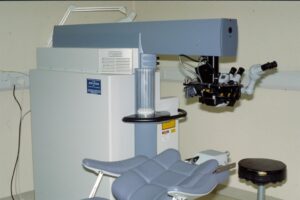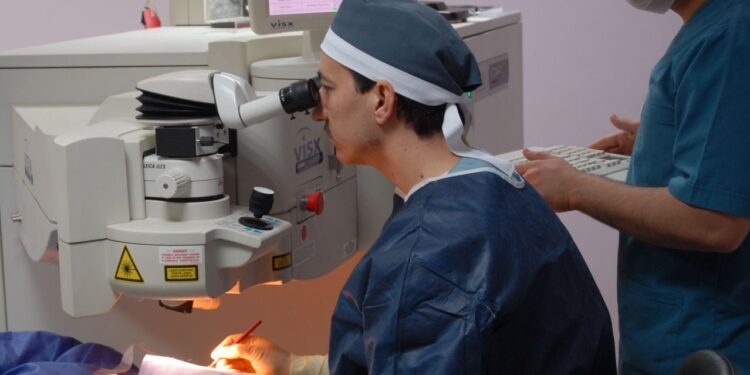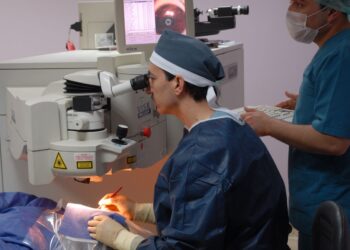Excimer laser in Turkiye

Excimer laser and eye surgery
Excimer lasers occupy an important place in the laser landscape and refractive surgery: they are the lasers of choice for emitting high-power radiation in short wavelengths such as ultraviolet. The photons in this ultraviolet range are more energetic than the infrared or visible spectrum photons. They can produce particular effects, such as photoablation of the cornea in surgery for myopia and other eye defects.
The excimer laser has revolutionized refractive surgery because it has brought a significant gain in terms of precision and safety to this discipline. The techniques of corneal refractive surgery with excimer laser dominate with supremacy in the landscape of surgical correction of visual defects such as myopia, hyperopia, or astigmatism. The use of the excimer laser is thus essential for a refractive surgeon. Femto-LASIK is based on the successive use of a femtosecond laser and an excimer laser.
Definition of the word “excimer”
“Excimer” is a contraction of the term “excited dimer.” The excitation medium of excimer lasers is gaseous and composed of rare gases (Helium, Argon, Krypton, etc.) or halides (Fluorine, Bromine, etc.). Rare gases occupy the last column on the right in the periodic table of the elements and halide the penultimate.
These elements are naturally reluctant to assemble, except under certain physical conditions that must be gathered in the laser cavity (high pressure, electric discharges): they can then form an excited dimer. Strictly speaking, a dimer is the assembly of two identical atoms, and the term “exiplex” should instead be used to characterize the assembly of two different monomers.
The excimer laser in Turkiye: to correct vision
The Excimer Laser Beam is an ultraviolet beam that sculpts the cornea with an accuracy of a quarter of a micron (a quarter of a thousandth of a millimeter !).
The high rate of shots (about 200 shots per second) makes processing very fast. The computer calculates the energy delivered for each patient to obtain the desired correction. The surgeon directs the procedure through the surgical microscope. An “eye tracking system controls the laser beam”; the computer records the eye’s movements and stops laser shots if there is a loss of fixation.
There are two very different techniques: Lasik and PKR. The excimer laser is present in all treatments (pkr, lasek, epilasik, lasik, ultra or intralasik); It is always the excimer laser that corrects the visual defect.
What is the difference between excimer, laser, and lasik?
The term “excimer” refers to the type of laser used to correct myopia on the cornea: it is a laser whose wavelength is in the ultraviolet (193 nm). This laser is used to sculpt the cornea, whether in surface laser (PKR) or LASIK.
The term “laser” is simply synonymous with the type of light used for this surgery (and in this type of intervention, it is the excimer laser). That said, the term “laser” is sometimes used by surgeons to refer to the “surface laser” (or PKR), as opposed to LASIK.
LASIK combines a corneal hood cut followed by photoablation (i.e., a sculpture of the underlying cornea) with the excimer laser. In LASIK, the excimer laser is ALWAYS used (and sometimes another laser, the femtosecond, to cut the hood – some surgeons use a mechanical instrument called a microkeratome for this cutting).

Who can benefit from excimer laser in Turkiye?
People with myopia up to 12 degrees, hypermetropia up to 6 degrees, and astigmatism up to 6 degrees who do not have some systemic diseases (diabetes – rheumatism, etc.) and chronic eye diseases (glaucoma, etc.) between the ages of 18-60 can benefit from excimer laser in Turkiye.
How do I know if my eyes suit an excimer laser in Turkiye?
Detailed Eye Examination for excimer laser in Turkiye: Your degree of vision, determination of your eye disorder, eye pressure measurement, and biomicroscopic examination are performed. Then the pupils of the eyes are enlarged with drops, the eye grades are determined again with drops, and a detailed examination of the bottom of the eye (retinal vascular structure and eye nerves) is performed.
- Examinations: In addition to a detailed eye examination, corneal topography, pachymetry, Epithelial Thickness Map, and pupillometer are performed. With these examinations, the shape and thickness of the corneal layer are evaluated for excimer laser in Turkiye.
- Topography: With Sirius, Orbscan, and Gallei examinations, the topographic map of the corneal layer of the eye is determined in detail for excimer laser in Turkiye.
- Pachymetry: The cornea thickness is measured. Corneal thickness is critical in determining the surgical method to apply for an excimer laser in Turkiye.
- Pupillometry: It is the process of measuring the diameter of the pupil. The pupil grows and shrinks according to the light intensity; in some people, the pupil is structurally wider. Especially in these people, the treatment planning according to this measurement aims to prevent unwanted situations such as light flashes, image dispersion, night vision problems, and halo after excimer laser in Turkiye.
Every eye is different exclusive laser treatment with bladeless laser technology with femtosecond.
How is Excimer Laser excimer laser in Turkiye (Getting Rid of Glasses) Treatment with Femtosecond Done?
- Step 1: Creation of a (3D) corneal map:
The corneal layer is unique to the person, just like fingerprints. With the corneal topography device, the specific characteristics of your eyes are determined quickly and safely; The three-dimensional map is extracted. This is a detailed map of the outer surface of your eye and how your eye directs light.
- Step 2: Creation of a cap (corneal flap) in the cornea:
In the traditional method, a circular incision is made using a knife by hand to form a corneal cap. With the Femtosecond device, this procedure is done entirely with tiny, flawless laser shots without contact with your eyes. When creating the cover, the 3D corneal map data created in the previous step is used so that the valve (flap) is created in the most appropriate position and in the most appropriate way for the structure of the eye.
- Step 3: Wavefront-guided Excimer Laser treatment:
After the cap removal with femtosecond, the cornea is reshaped by applying the laser process.

What happens after the operation of the excimer laser in Turkiye?
Burning, watery eyes and blurred vision for 4-5 hours are expected. Drops are used every 1-2 hours. After a 5-minute check-up the next day, the patients can return to their daily work.
What should I take care to after the operation of the excimer laser in Turkiye?
The day after the operation, you can take a bath and wash your face (keeping the eyes closed) without getting soap and shampoo in the eyes. You should not enter the pool and sea for three weeks, and eye makeup should not be applied for two weeks. Avoid rubbing and scratching the eyes.












Discussion about this post